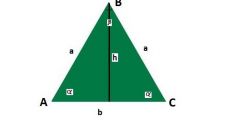You will need
- Knowledge of geometry.
Instruction
1
By the Pythagorean theorem square length of the hypotenuse is equal to the sum of the squares of the other two sides. As given an isosceles triangle, it has several properties, one of which States that the angles at the base of an isosceles triangle are equal. Any triangle has the property that the sum of all its angles is equal to 180 degrees. From these two properties it follows that a right angle isosceles triangle can only lie in front of the base, and hence base of the triangle is the hypotenuse, and the sides of the legs.
2
Given the length of the sides of an isosceles triangle a = 3. Since the sides of isosceles triangle are equal, then the second side is also equal to the three a = b = 3. In the previous step it was shown that the sides are the sides if an isosceles triangle, and even rectangular. Use the Pythagorean theorem to find the hypotenuse: a^2 = a^2 + b^2. Since a = b, then the formula will be written in the following form: s^2 = 2*a^2.
3
Substitute the value of the length of sides in the resulting formula and get the answer - the length of the hypotenuse. with^2 = 2 * 3^2 = 18. So the hypotenuse squared is equal to 18. Extract the square root of 18 and you will receive, what is the hypotenuse: C = 4.24. Thus received, that the length of the sides of an isosceles right triangle is equal to 3, the length of the hypotenuse is 4.24.
Note
The length of the hypotenuse, like any length, the value is always non-negative.
Useful advice
From the fact that the isosceles triangle and rectangular, it follows that its area is half the area of a square with sides equal to the length of the side and base of this triangle is equal to the diagonal of such a square.


